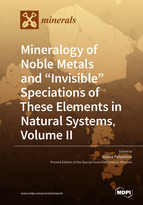Mineralogy of Noble Metals and “Invisible” Speciations of These Elements in Natural Systems, Volume II
A special issue of Minerals (ISSN 2075-163X). This special issue belongs to the section "Mineral Deposits".
Deadline for manuscript submissions: closed (28 February 2021) | Viewed by 39376
Special Issue Editor
2. Department of Geology and Geophysics, Novosibirsk State University, 630090 Novosibirsk, Russia
Interests: ore-forming processes; experiment; thermodynamic modeling; minerals-indicators; fluid−mineral−rock interactions; gold mineralization; gold deposits; mechanisms of ore formation; reconstruction of T,P,X-conditions
Special Issues, Collections and Topics in MDPI journals
Special Issue Information
Dear Colleagues,
The mineralogy of gold and other noble metals is very diverse. The articles published in the Special Issue of 2019 do not cover all the stated problems of the specified topic and, hence, it is expedient and relevant to continue it and release a 2nd volume. At present, a significant part of the reserves of gold and other noble metals are primary deposits of sulfide ores. Many sulfide ores are referred to as refractory ores by technologists. Knowledge of the mineralogy of these ores, including data on their own minerals (micro, nano-) and invisible forms of noble metals, is the key factor in developing rational schemes of their processing and enrichment. The aim of the new volume is to attract the attention of researchers from many fields to gain new knowledge for solving fundamental and applied tasks.
Dr. Galina Palyanova
Guest Editor
Manuscript Submission Information
Manuscripts should be submitted online at www.mdpi.com by registering and logging in to this website. Once you are registered, click here to go to the submission form. Manuscripts can be submitted until the deadline. All submissions that pass pre-check are peer-reviewed. Accepted papers will be published continuously in the journal (as soon as accepted) and will be listed together on the special issue website. Research articles, review articles as well as short communications are invited. For planned papers, a title and short abstract (about 100 words) can be sent to the Editorial Office for announcement on this website.
Submitted manuscripts should not have been published previously, nor be under consideration for publication elsewhere (except conference proceedings papers). All manuscripts are thoroughly refereed through a single-blind peer-review process. A guide for authors and other relevant information for submission of manuscripts is available on the Instructions for Authors page. Minerals is an international peer-reviewed open access monthly journal published by MDPI.
Please visit the Instructions for Authors page before submitting a manuscript. The Article Processing Charge (APC) for publication in this open access journal is 2400 CHF (Swiss Francs). Submitted papers should be well formatted and use good English. Authors may use MDPI's English editing service prior to publication or during author revisions.
Keywords
- Mineralogy of gold and other noble metals in sulfide ores
- New minerals of noble metals
- The geochemistry of noble metals
- Chemistry and scales of processes of dissolution, transport and deposition of noble metals
- “Invisible” speciations of gold, silver, platinum, and palladium in sulfides and other minerals
- Processes of consolidation, aggregation, and mechanisms of formation of noble metal nuggets
- Models for the formation of deposits of noble metals
- Chemical composition of native gold
- Technologies for the extraction of noble metals from refractory sulfide ores
- Noble metal biogeochemistry






